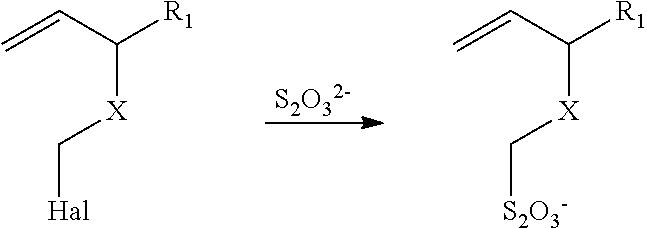Thiosulfate polymer compositions and articles
a technology of thiosulfate and composition, applied in the field of polymer, can solve the problems of inability to achieve the effect of large-scale production, inability to efficiently decompose bunte salts, and inability to use bunte salt polymers in simple patterning thin films, etc., and achieves low cost through large-scale production and high adhesive strength
- Summary
- Abstract
- Description
- Claims
- Application Information
AI Technical Summary
Benefits of technology
Problems solved by technology
Method used
Image
Examples
##ventive example 1
Inventive Example 1
Preparation of Poly(vinyl benzyl thiosulfate sodium salt-co-methyl methacrylate-co-N-butyl-N′-[2-(ethoxy-2-acrylate)ethyl]-1,4,5,8-naphthalenetetracarboxylic diimide)
[0264]The procedure of Synthesis 1 was followed using vinyl benzyl chloride (4.2 g, 0.027 mol), methyl methacrylate (8.5 g, 0.085 mol), the noted diimide (1.1 g, 0.002 mol), 2,2′-azobis(2-methylbutyronitrile) (0.33 g, 0.002 mol), and 47 ml of toluene. The reaction temperature was 70° C. 1H NMR analysis indicated that the resulting precursor polymer contained 30 mol % of recurring units derived from vinyl benzyl chloride. Analysis by size exclusion chromatography (SEC) indicated a weight average molar mass of 17,800 (polystyrene standards).
[0265]The desired thiosulfate polymer was prepared as described in Synthesis 1 using 1.35 g of precursor polymer, 50 ml of DMF, 1.5 g of sodium thiosulfate, and 10 ml of water. The temperature of the reaction solution was 90° C. for 8 hours. The thiosulfate polymer g...
##ventive example 2
Inventive Example 2
Preparation of Poly(vinyl benzyl thiosulfate sodium salt-co-methyl methacrylate-co-acrylic acid-co-N-butyl-N′-[2-(ethoxy-2-acrylate)ethyl]-1,4,5,8-naphthalene-tetracarboxylic diimide)
[0266]The procedure of Synthesis 1 was followed using vinyl benzyl chloride (8.2 g, 0.053 mol), methyl methacrylate (8.5 g, 0.085 mol), acrylic acid (8.5 g, 0.119 mol), the diimide (2.3 g, 0.005 mol), 2,2′-azobis(2-methylbutyronitrile) (0.76 g, 0.004 mol), and 90 ml of dioxane. The reaction temperature was 70° C. 1H NMR analysis indicated that the resulting precursor polymer contained 30 mol % of recurring units derived from vinyl benzyl chloride. Analysis by size exclusion chromatography (SEC) indicated a weight average molar mass of 41,600 (polystyrene standards).
[0267]The desired thiosulfate polymer was prepared as described in Synthesis 1 using 26.1 g of precursor polymer, 285 ml of DMF, 8.5 g sodium thiosulfate, and 57 ml of water. The temperature of reaction was held at 90° C. f...
##ventive example 3
Inventive Example 3
Preparation of Poly(vinyl benzyl thiosulfate sodium salt-co-acrylic acid-co-N-butyl-N′-[2-(ethoxy-2-acrylate)ethyl]-1,4,5,8-naphthalenetetracarboxylic diimide)
[0268]The procedure of Synthesis 1 was followed using vinyl benzyl chloride (7.3 g, 0.048 mol), acrylic acid (15.0 g, 0.21 mol), the diimide (1.9 g, 0.005 mol), 2,2′-azobis(2-methylbutyronitrile) (0.76 g, 0.004 mol), and 73 ml of dioxane. The reaction temperature was 70° C. 1H NMR analysis indicated that the resulting precursor polymer contained 31 mol % of recurring units derived from vinyl benzyl chloride. Analysis by size exclusion chromatography (SEC) indicated a weight average molar mass of 21,400 (polystyrene standards).
[0269]The desired thiosulfate polymer was prepared as described in Synthesis 1 using 20.0 g of precursor polymer, 250 ml of DMF, 6.5 g sodium thiosulfate, and 50 ml of water. The reaction temperature was 90° C. for 8 hours to provide the desired thiosulfate polymer that had a glass tran...
PUM
| Property | Measurement | Unit |
|---|---|---|
| Tg | aaaaa | aaaaa |
| Tg | aaaaa | aaaaa |
| Tg | aaaaa | aaaaa |
Abstract
Description
Claims
Application Information
 Login to View More
Login to View More - R&D
- Intellectual Property
- Life Sciences
- Materials
- Tech Scout
- Unparalleled Data Quality
- Higher Quality Content
- 60% Fewer Hallucinations
Browse by: Latest US Patents, China's latest patents, Technical Efficacy Thesaurus, Application Domain, Technology Topic, Popular Technical Reports.
© 2025 PatSnap. All rights reserved.Legal|Privacy policy|Modern Slavery Act Transparency Statement|Sitemap|About US| Contact US: help@patsnap.com



